DODGE DAKOTA 2011 3.G Manual PDF
Manufacturer: DODGE, Model Year: 2011, Model line: DAKOTA, Model: DODGE DAKOTA 2011 3.GPages: 452, PDF Size: 4.92 MB
Page 71 of 452
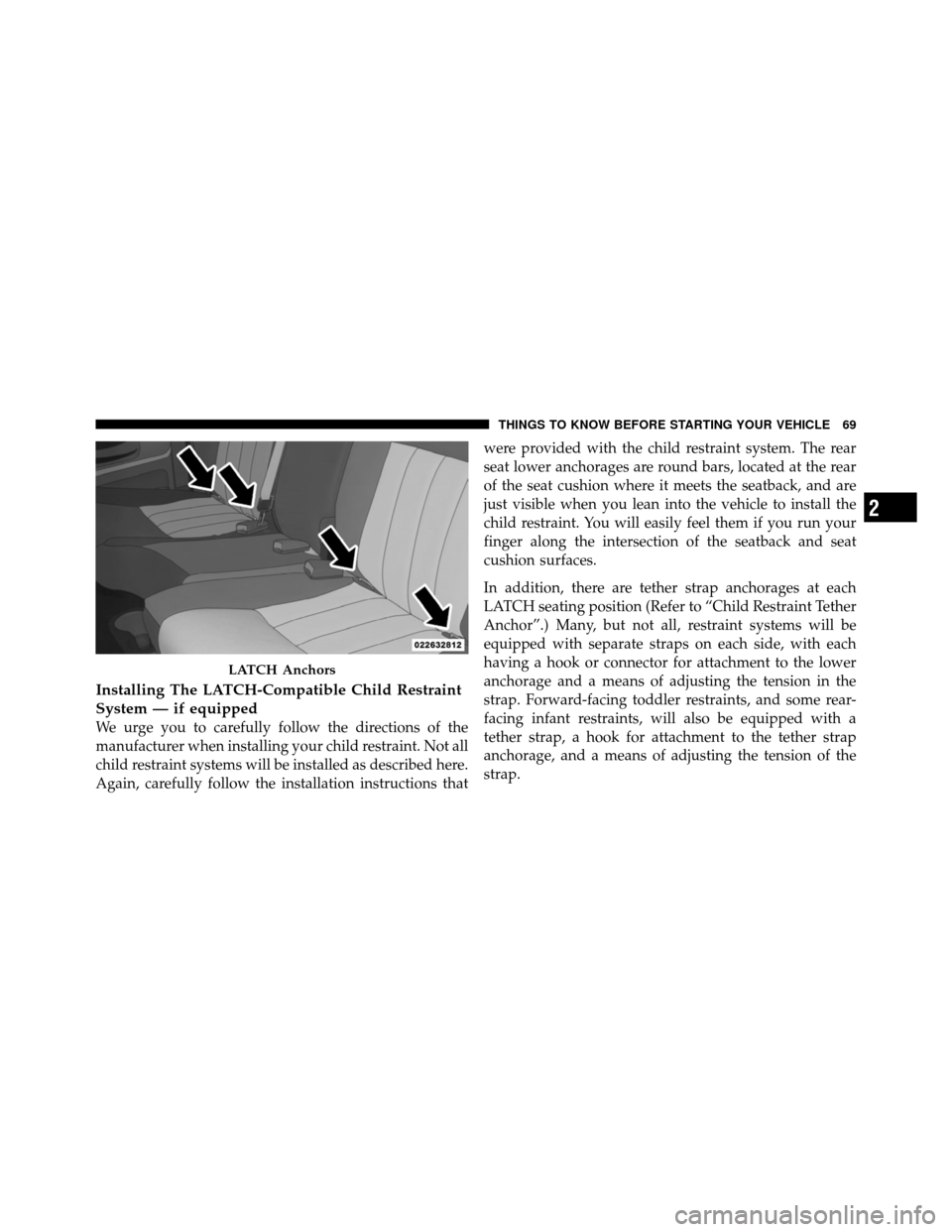
Installing The LATCH-Compatible Child Restraint
System — if equipped
We urge you to carefully follow the directions of the
manufacturer when installing your child restraint. Not all
child restraint systems will be installed as described here.
Again, carefully follow the installation instructions thatwere provided with the child restraint system. The rear
seat lower anchorages are round bars, located at the rear
of the seat cushion where it meets the seatback, and are
just visible when you lean into the vehicle to install the
child restraint. You will easily feel them if you run your
finger along the intersection of the seatback and seat
cushion surfaces.
In addition, there are tether strap anchorages at each
LATCH seating position (Refer to “Child Restraint Tether
Anchor”.) Many, but not all, restraint systems will be
equipped with separate straps on each side, with each
having a hook or connector for attachment to the lower
anchorage and a means of adjusting the tension in the
strap. Forward-facing toddler restraints, and some rear-
facing infant restraints, will also be equipped with a
tether strap, a hook for attachment to the tether strap
anchorage, and a means of adjusting the tension of the
strap.
LATCH Anchors
2
THINGS TO KNOW BEFORE STARTING YOUR VEHICLE 69
Page 72 of 452
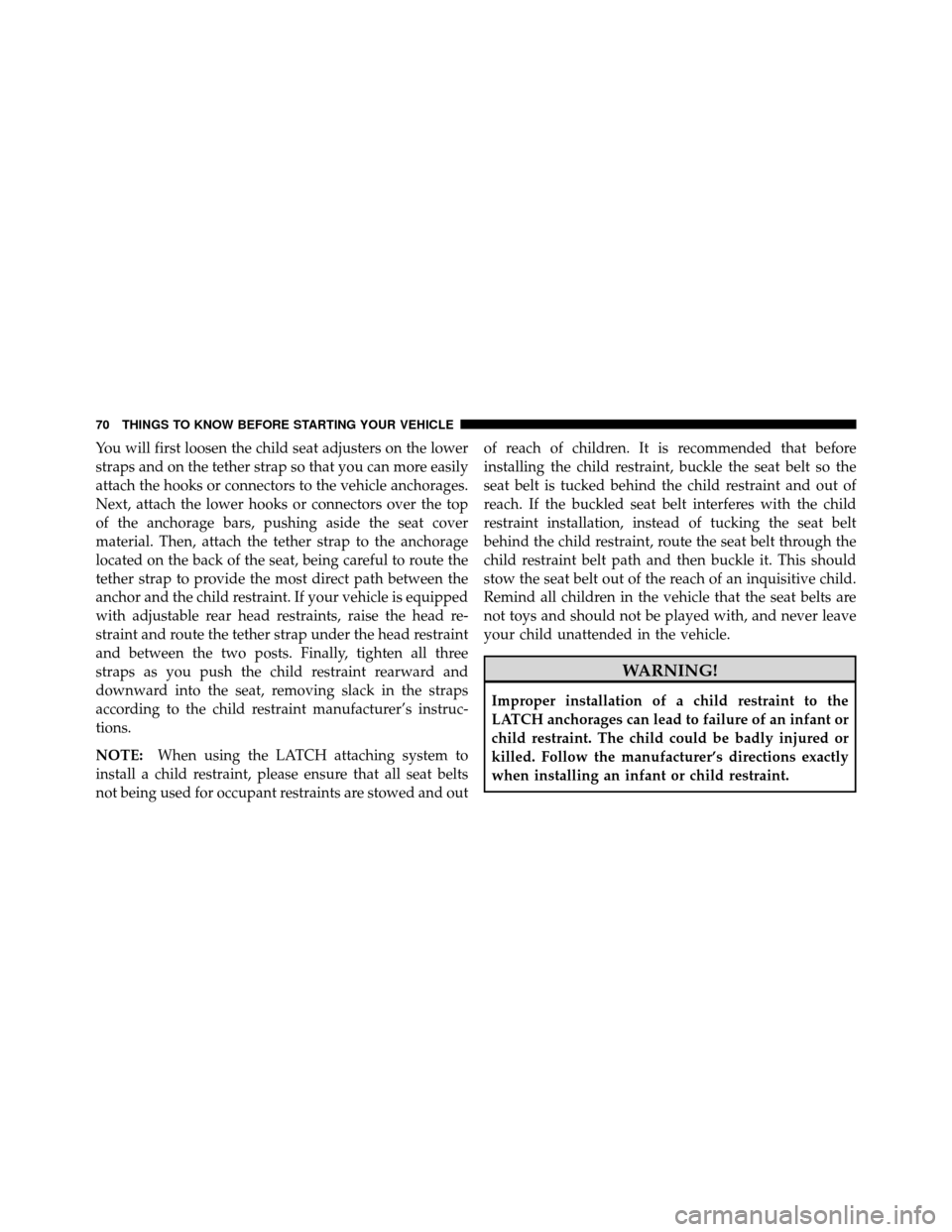
You will first loosen the child seat adjusters on the lower
straps and on the tether strap so that you can more easily
attach the hooks or connectors to the vehicle anchorages.
Next, attach the lower hooks or connectors over the top
of the anchorage bars, pushing aside the seat cover
material. Then, attach the tether strap to the anchorage
located on the back of the seat, being careful to route the
tether strap to provide the most direct path between the
anchor and the child restraint. If your vehicle is equipped
with adjustable rear head restraints, raise the head re-
straint and route the tether strap under the head restraint
and between the two posts. Finally, tighten all three
straps as you push the child restraint rearward and
downward into the seat, removing slack in the straps
according to the child restraint manufacturer’s instruc-
tions.
NOTE:When using the LATCH attaching system to
install a child restraint, please ensure that all seat belts
not being used for occupant restraints are stowed and out of reach of children. It is recommended that before
installing the child restraint, buckle the seat belt so the
seat belt is tucked behind the child restraint and out of
reach. If the buckled seat belt interferes with the child
restraint installation, instead of tucking the seat belt
behind the child restraint, route the seat belt through the
child restraint belt path and then buckle it. This should
stow the seat belt out of the reach of an inquisitive child.
Remind all children in the vehicle that the seat belts are
not toys and should not be played with, and never leave
your child unattended in the vehicle.
WARNING!
Improper installation of a child restraint to the
LATCH anchorages can lead to failure of an infant or
child restraint. The child could be badly injured or
killed. Follow the manufacturer’s directions exactly
when installing an infant or child restraint.
70 THINGS TO KNOW BEFORE STARTING YOUR VEHICLE
Page 73 of 452
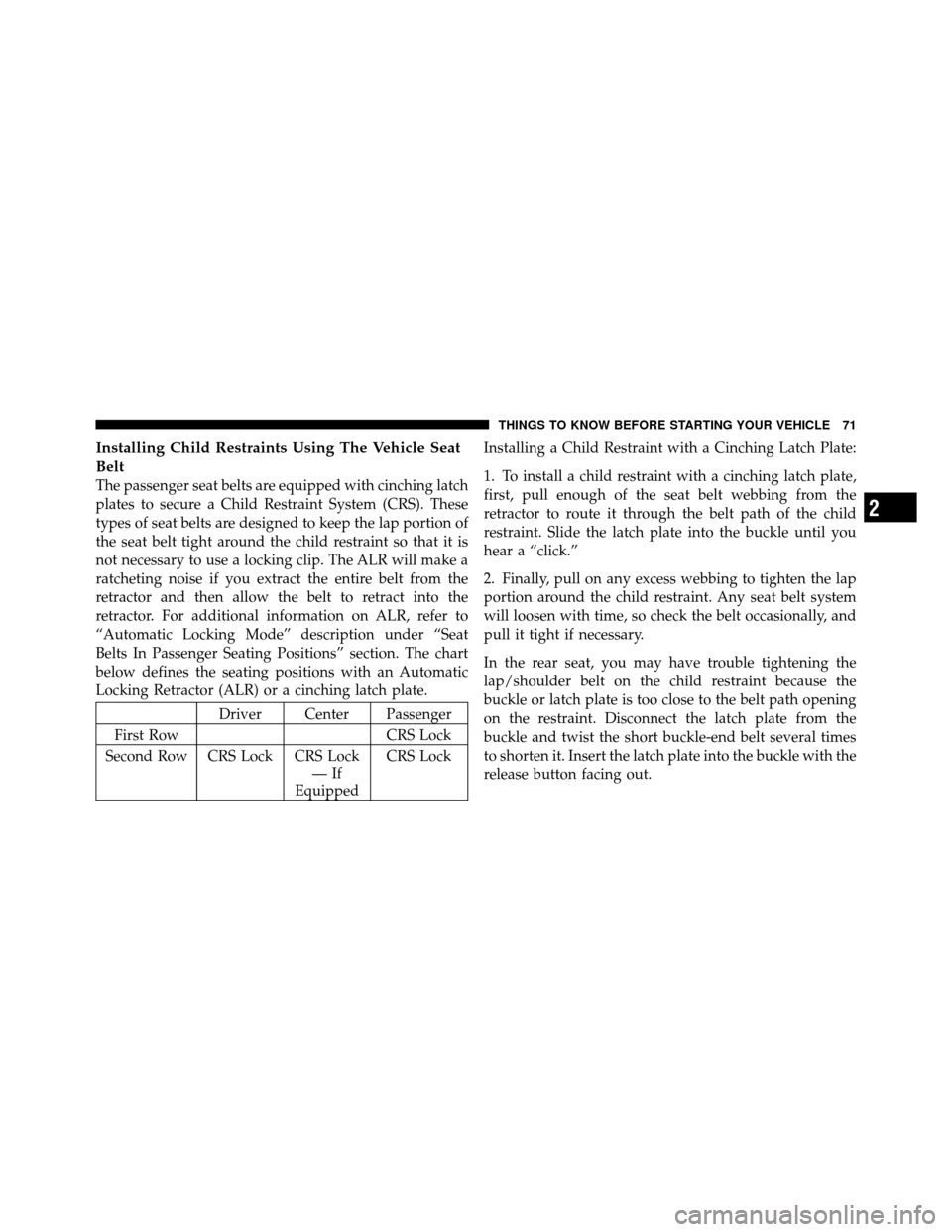
Installing Child Restraints Using The Vehicle Seat
Belt
The passenger seat belts are equipped with cinching latch
plates to secure a Child Restraint System (CRS). These
types of seat belts are designed to keep the lap portion of
the seat belt tight around the child restraint so that it is
not necessary to use a locking clip. The ALR will make a
ratcheting noise if you extract the entire belt from the
retractor and then allow the belt to retract into the
retractor. For additional information on ALR, refer to
“Automatic Locking Mode” description under “Seat
Belts In Passenger Seating Positions” section. The chart
below defines the seating positions with an Automatic
Locking Retractor (ALR) or a cinching latch plate.
Driver Center Passenger
First Row CRS Lock
Second Row CRS Lock CRS Lock —If
Equipped CRS Lock Installing a Child Restraint with a Cinching Latch Plate:
1. To install a child restraint with a cinching latch plate,
first, pull enough of the seat belt webbing from the
retractor to route it through the belt path of the child
restraint. Slide the latch plate into the buckle until you
hear a “click.”
2. Finally, pull on any excess webbing to tighten the lap
portion around the child restraint. Any seat belt system
will loosen with time, so check the belt occasionally, and
pull it tight if necessary.
In the rear seat, you may have trouble tightening the
lap/shoulder belt on the child restraint because the
buckle or latch plate is too close to the belt path opening
on the restraint. Disconnect the latch plate from the
buckle and twist the short buckle-end belt several times
to shorten it. Insert the latch plate into the buckle with the
release button facing out.
2
THINGS TO KNOW BEFORE STARTING YOUR VEHICLE 71
Page 74 of 452
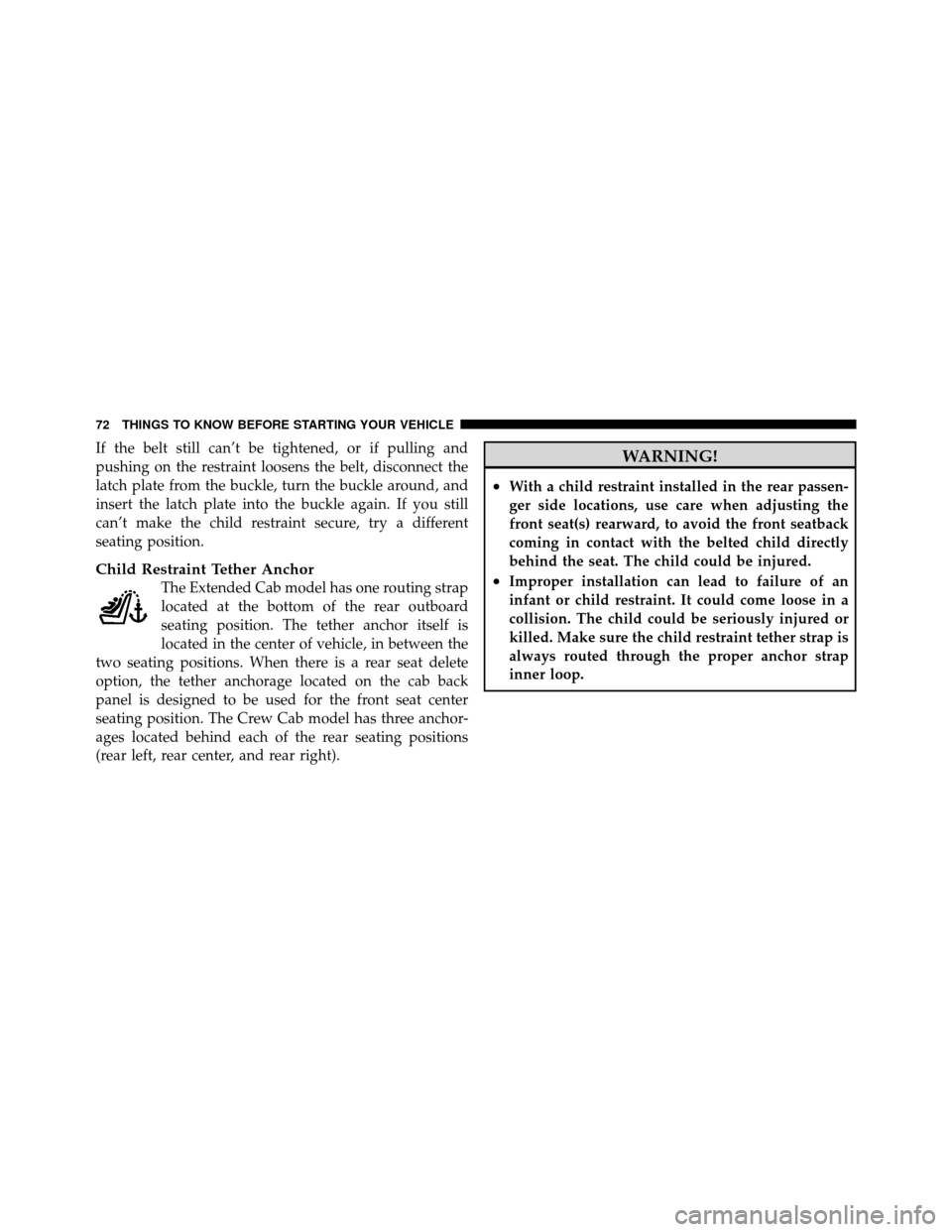
If the belt still can’t be tightened, or if pulling and
pushing on the restraint loosens the belt, disconnect the
latch plate from the buckle, turn the buckle around, and
insert the latch plate into the buckle again. If you still
can’t make the child restraint secure, try a different
seating position.
Child Restraint Tether Anchor
The Extended Cab model has one routing strap
located at the bottom of the rear outboard
seating position. The tether anchor itself is
located in the center of vehicle, in between the
two seating positions. When there is a rear seat delete
option, the tether anchorage located on the cab back
panel is designed to be used for the front seat center
seating position. The Crew Cab model has three anchor-
ages located behind each of the rear seating positions
(rear left, rear center, and rear right).
WARNING!
•With a child restraint installed in the rear passen-
ger side locations, use care when adjusting the
front seat(s) rearward, to avoid the front seatback
coming in contact with the belted child directly
behind the seat. The child could be injured.
•Improper installation can lead to failure of an
infant or child restraint. It could come loose in a
collision. The child could be seriously injured or
killed. Make sure the child restraint tether strap is
always routed through the proper anchor strap
inner loop.
72 THINGS TO KNOW BEFORE STARTING YOUR VEHICLE
Page 75 of 452
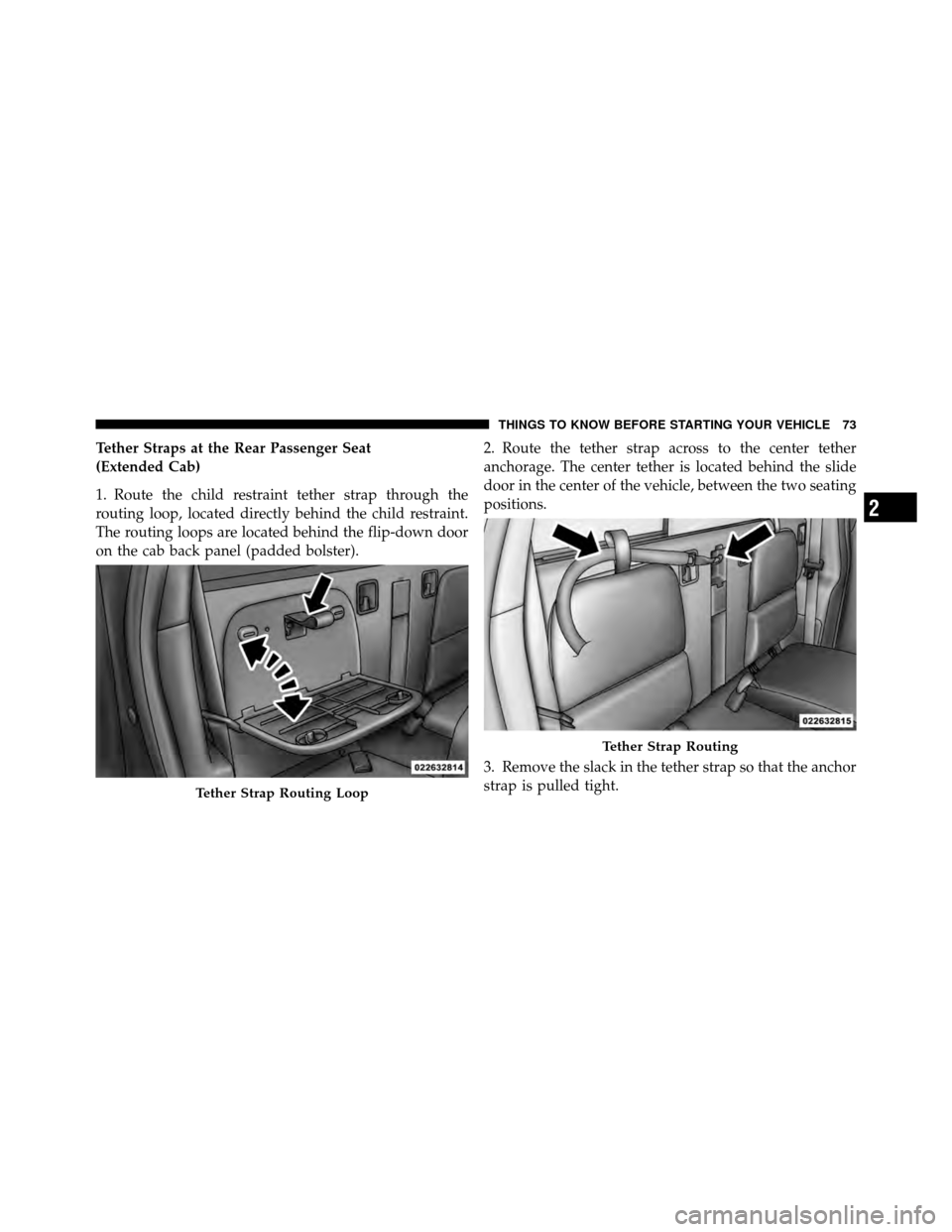
Tether Straps at the Rear Passenger Seat
(Extended Cab)
1. Route the child restraint tether strap through the
routing loop, located directly behind the child restraint.
The routing loops are located behind the flip-down door
on the cab back panel (padded bolster).2. Route the tether strap across to the center tether
anchorage. The center tether is located behind the slide
door in the center of the vehicle, between the two seating
positions.
3. Remove the slack in the tether strap so that the anchor
strap is pulled tight.
Tether Strap Routing Loop
Tether Strap Routing
2
THINGS TO KNOW BEFORE STARTING YOUR VEHICLE 73
Page 76 of 452
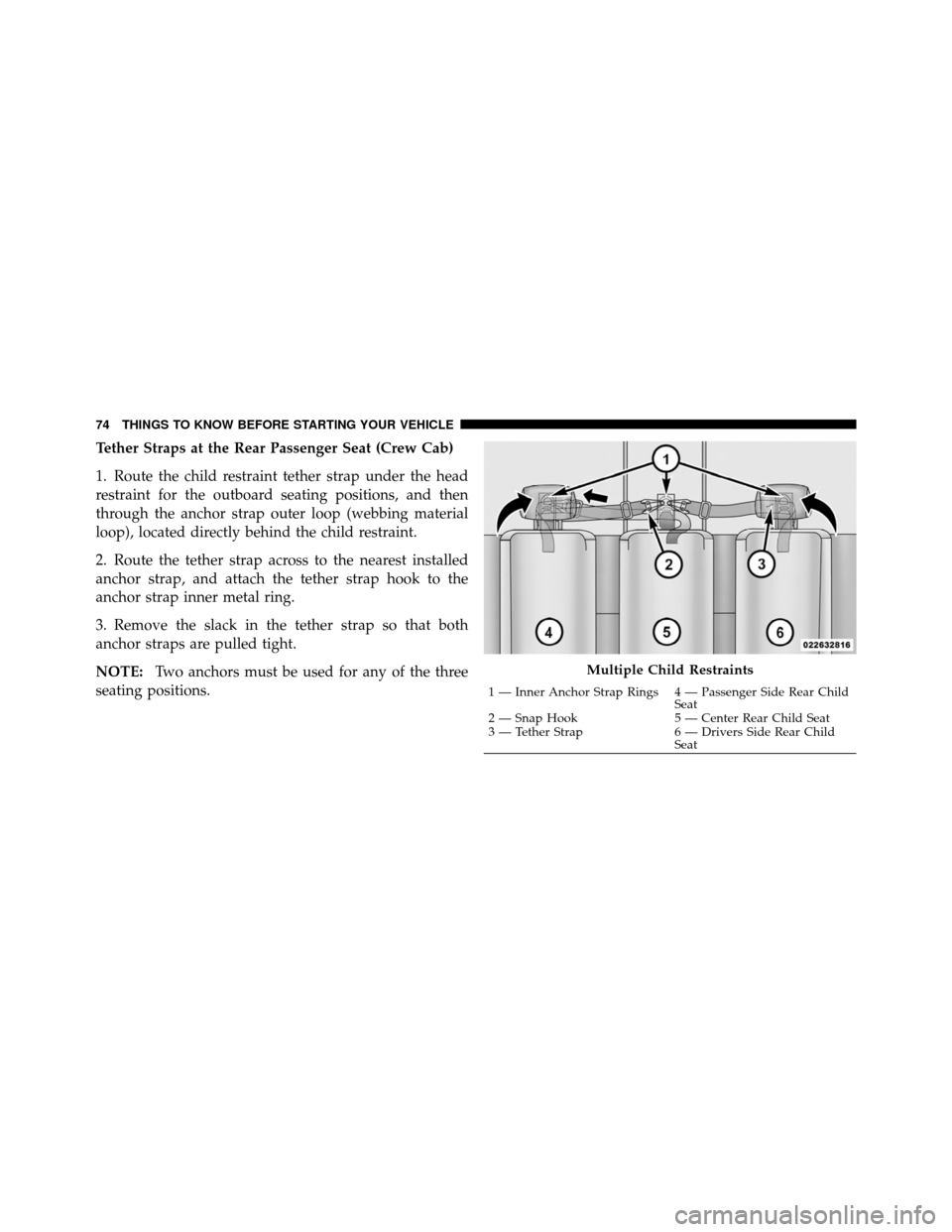
Tether Straps at the Rear Passenger Seat (Crew Cab)
1. Route the child restraint tether strap under the head
restraint for the outboard seating positions, and then
through the anchor strap outer loop (webbing material
loop), located directly behind the child restraint.
2. Route the tether strap across to the nearest installed
anchor strap, and attach the tether strap hook to the
anchor strap inner metal ring.
3. Remove the slack in the tether strap so that both
anchor straps are pulled tight.
NOTE:Two anchors must be used for any of the three
seating positions.
Multiple Child Restraints
1 — Inner Anchor Strap Rings 4 — Passenger Side Rear Child Seat
2 — Snap Hook 5 — Center Rear Child Seat
3 — Tether Strap 6 — Drivers Side Rear Child Seat
74 THINGS TO KNOW BEFORE STARTING YOUR VEHICLE
Page 77 of 452
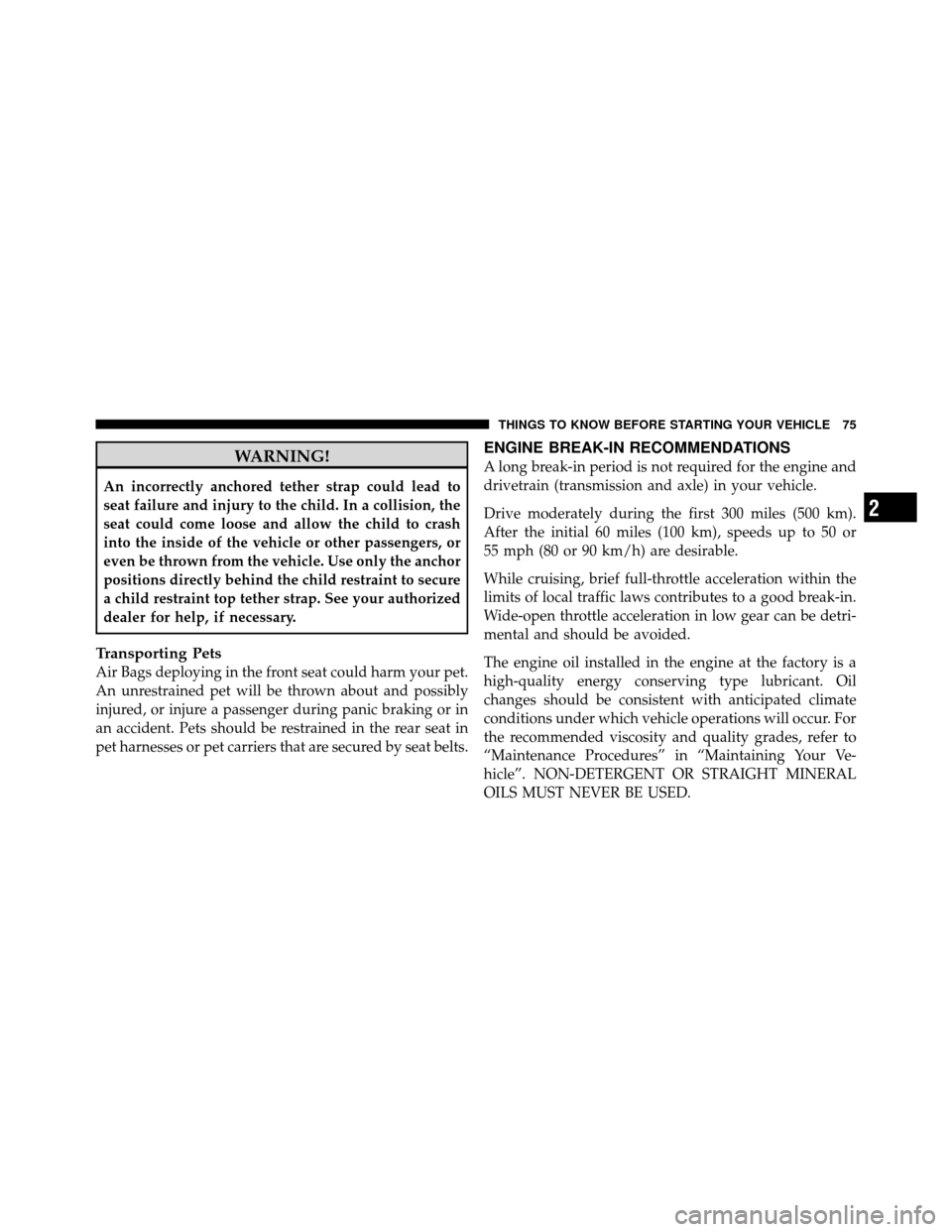
WARNING!
An incorrectly anchored tether strap could lead to
seat failure and injury to the child. In a collision, the
seat could come loose and allow the child to crash
into the inside of the vehicle or other passengers, or
even be thrown from the vehicle. Use only the anchor
positions directly behind the child restraint to secure
a child restraint top tether strap. See your authorized
dealer for help, if necessary.
Transporting Pets
Air Bags deploying in the front seat could harm your pet.
An unrestrained pet will be thrown about and possibly
injured, or injure a passenger during panic braking or in
an accident. Pets should be restrained in the rear seat in
pet harnesses or pet carriers that are secured by seat belts.
ENGINE BREAK-IN RECOMMENDATIONS
A long break-in period is not required for the engine and
drivetrain (transmission and axle) in your vehicle.
Drive moderately during the first 300 miles (500 km).
After the initial 60 miles (100 km), speeds up to 50 or
55 mph (80 or 90 km/h) are desirable.
While cruising, brief full-throttle acceleration within the
limits of local traffic laws contributes to a good break-in.
Wide-open throttle acceleration in low gear can be detri-
mental and should be avoided.
The engine oil installed in the engine at the factory is a
high-quality energy conserving type lubricant. Oil
changes should be consistent with anticipated climate
conditions under which vehicle operations will occur. For
the recommended viscosity and quality grades, refer to
“Maintenance Procedures” in “Maintaining Your Ve-
hicle”. NON-DETERGENT OR STRAIGHT MINERAL
OILS MUST NEVER BE USED.
2
THINGS TO KNOW BEFORE STARTING YOUR VEHICLE 75
Page 78 of 452
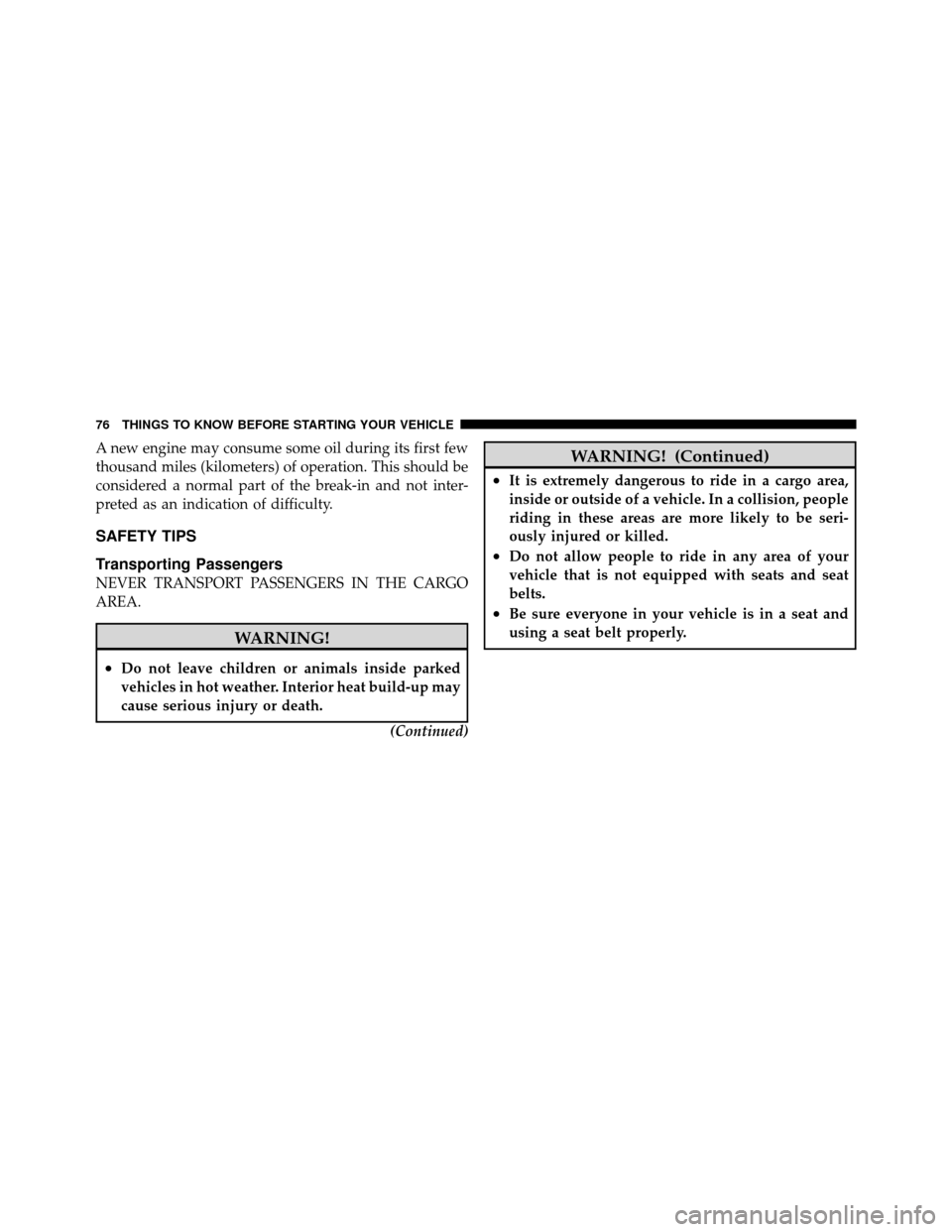
A new engine may consume some oil during its first few
thousand miles (kilometers) of operation. This should be
considered a normal part of the break-in and not inter-
preted as an indication of difficulty.
SAFETY TIPS
Transporting Passengers
NEVER TRANSPORT PASSENGERS IN THE CARGO
AREA.
WARNING!
•Do not leave children or animals inside parked
vehicles in hot weather. Interior heat build-up may
cause serious injury or death.(Continued)
WARNING! (Continued)
•It is extremely dangerous to ride in a cargo area,
inside or outside of a vehicle. In a collision, people
riding in these areas are more likely to be seri-
ously injured or killed.
•Do not allow people to ride in any area of your
vehicle that is not equipped with seats and seat
belts.
•Be sure everyone in your vehicle is in a seat and
using a seat belt properly.
76 THINGS TO KNOW BEFORE STARTING YOUR VEHICLE
Page 79 of 452
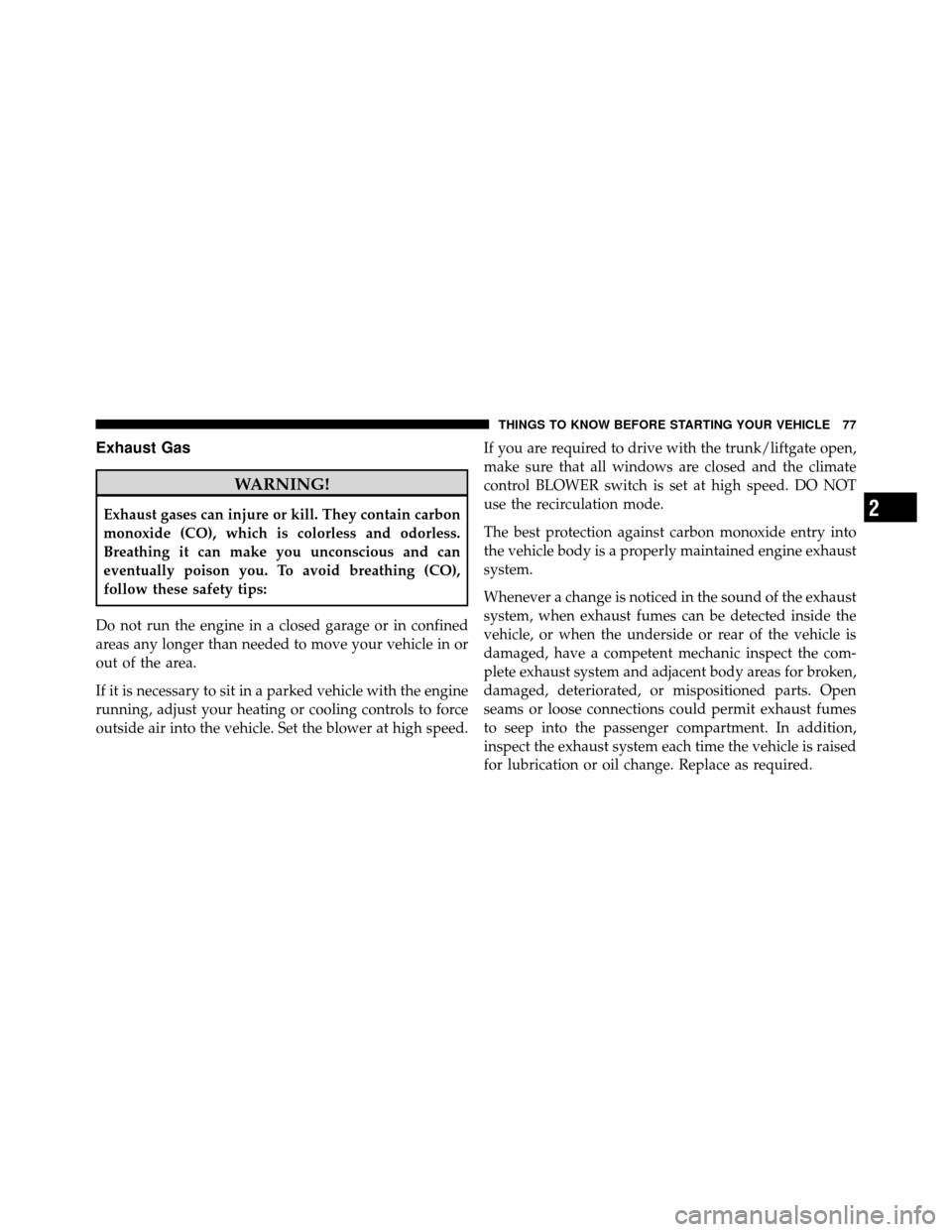
Exhaust Gas
WARNING!
Exhaust gases can injure or kill. They contain carbon
monoxide (CO), which is colorless and odorless.
Breathing it can make you unconscious and can
eventually poison you. To avoid breathing (CO),
follow these safety tips:
Do not run the engine in a closed garage or in confined
areas any longer than needed to move your vehicle in or
out of the area.
If it is necessary to sit in a parked vehicle with the engine
running, adjust your heating or cooling controls to force
outside air into the vehicle. Set the blower at high speed. If you are required to drive with the trunk/liftgate open,
make sure that all windows are closed and the climate
control BLOWER switch is set at high speed. DO NOT
use the recirculation mode.
The best protection against carbon monoxide entry into
the vehicle body is a properly maintained engine exhaust
system.
Whenever a change is noticed in the sound of the exhaust
system, when exhaust fumes can be detected inside the
vehicle, or when the underside or rear of the vehicle is
damaged, have a competent mechanic inspect the com-
plete exhaust system and adjacent body areas for broken,
damaged, deteriorated, or mispositioned parts. Open
seams or loose connections could permit exhaust fumes
to seep into the passenger compartment. In addition,
inspect the exhaust system each time the vehicle is raised
for lubrication or oil change. Replace as required.2
THINGS TO KNOW BEFORE STARTING YOUR VEHICLE 77
Page 80 of 452
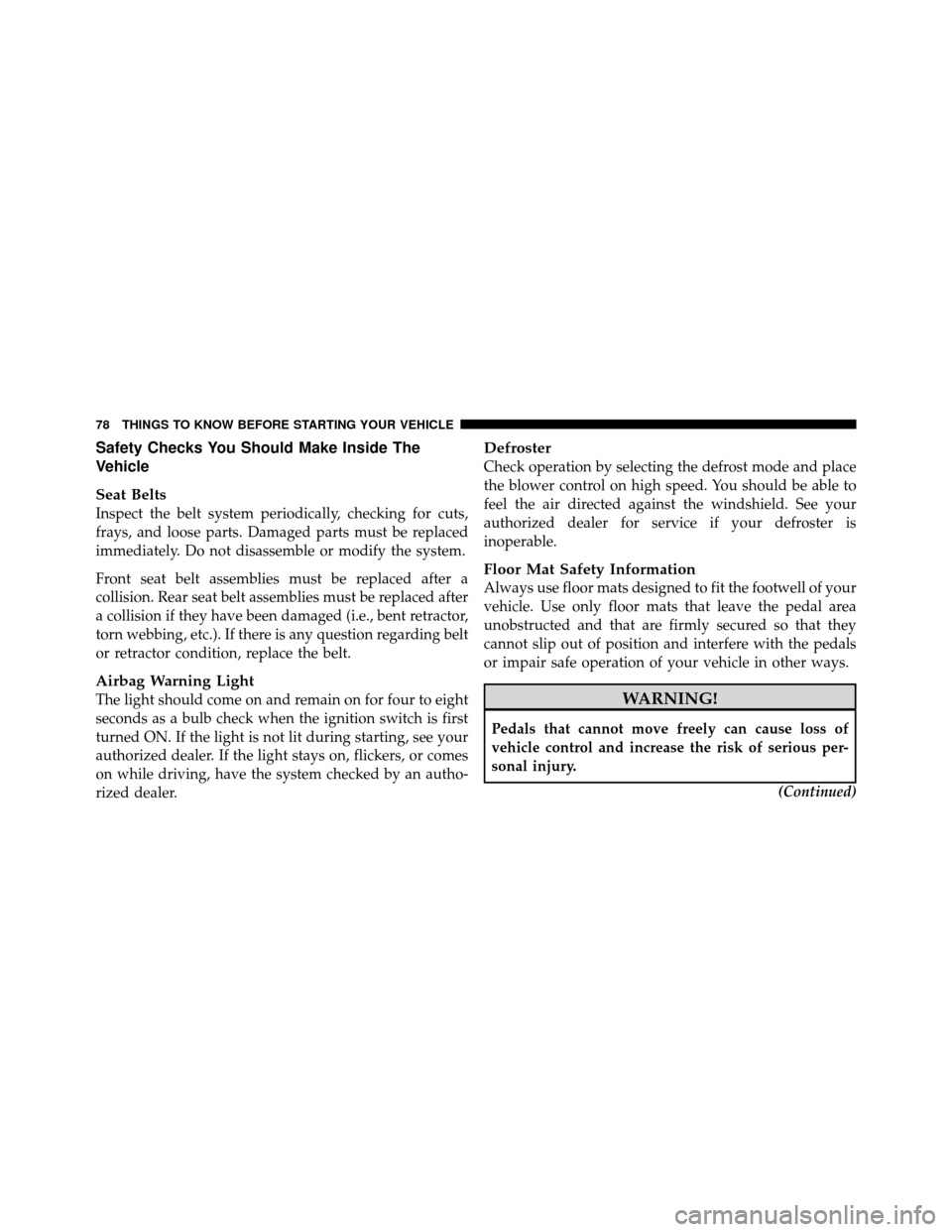
Safety Checks You Should Make Inside The
Vehicle
Seat Belts
Inspect the belt system periodically, checking for cuts,
frays, and loose parts. Damaged parts must be replaced
immediately. Do not disassemble or modify the system.
Front seat belt assemblies must be replaced after a
collision. Rear seat belt assemblies must be replaced after
a collision if they have been damaged (i.e., bent retractor,
torn webbing, etc.). If there is any question regarding belt
or retractor condition, replace the belt.
Airbag Warning Light
The light should come on and remain on for four to eight
seconds as a bulb check when the ignition switch is first
turned ON. If the light is not lit during starting, see your
authorized dealer. If the light stays on, flickers, or comes
on while driving, have the system checked by an autho-
rized dealer.
Defroster
Check operation by selecting the defrost mode and place
the blower control on high speed. You should be able to
feel the air directed against the windshield. See your
authorized dealer for service if your defroster is
inoperable.
Floor Mat Safety Information
Always use floor mats designed to fit the footwell of your
vehicle. Use only floor mats that leave the pedal area
unobstructed and that are firmly secured so that they
cannot slip out of position and interfere with the pedals
or impair safe operation of your vehicle in other ways.
WARNING!
Pedals that cannot move freely can cause loss of
vehicle control and increase the risk of serious per-
sonal injury.(Continued)
78 THINGS TO KNOW BEFORE STARTING YOUR VEHICLE